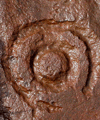News & Events
Ancient Rock Art at Risk

Researchers from the International Centre for Cultural and Heritage Studies (ICCHS) and School of Civil Engineering and Geosciences (CEG) studied the physical underpinnings and condition of Neolithic and Bronze Age rock art panels in Northumberland. They conclude climate change could cause the art to vanish because new evidence suggests stones may deteriorate more rapidly in the future.
Writing in the Journal of Cultural and Heritage Studies, they say urgent action is needed so the art can be preserved for future generations, but they also urge that a deeper understanding is needed of what causes rock art to deteriorate.
David Graham, Professor of Ecosystems Engineering (CEG) said: “We wanted to understand the scientific reasons why these stones may deteriorate. Our findings show that predicted changes to our broader environment – such as more wind and warmer, wetter weather - could have a devastating effect on these artworks. If we want to keep them, we need to start looking at how we can preserve them now.”
Dr Aron Mazel , Director of ICCHS at Newcastle University, said: “People think rocks are permanent and that because rock art seems to have been there for a very long time , it will last forever. Sadly, this is not the case and some of the world’s most interesting art could be at risk. We need to act now if we want this art, which was created by humans thousands and thousands of years ago, to be there in the future.”
Rock art is one of the earliest forms of artistic expression and emerged in different parts of the world over 50,000 years ago. In Northumberland in Northern England, the rock art, which is between 6000 and 4000 years old, is mostly found on sandstone and the decoration is usually defined by cup-like features or complex patterns of cups, rings and grooves.
The team, working with Dr Patricia Warke at Queen’s University, Belfast, studied 18 panels at locations across Northumberland. They first assessed the actual condition of the rock art panels and then compared it with 27 geochemical and physical factors such as soil moisture, salinity, pH levels and height.
They found two factors were closely related to greater stone deterioration, the height of a panel and the level of exchangeable cations (ions) in the local soils.
The team is now developing a toolkit for landowners and managers to provide guidance on identifying and protecting rock art which is most at risk.
Lead author Dr Myra Giesen from the ICCHS said: “Urgent attention is needed to identify those most at risk so the rock art can be saved and preventative steps can be taken, such as improving drainage around the panels. We are developing a toolkit so landowners can do this themselves. This is really important as they are the first line of defence.”
Giesen also indicated: “We are also carrying out further research in other locations in the UK and the Republic of Ireland to understand how rock art created on other stones may be affected.”
Ends
Notes to editors
• The paper: Condition assessment and preservation of open-air rock art panels during climate change can be found here.
published on: 14th March 2013
Last modified: Thu, 25 Apr 2013 10:49:34 BST